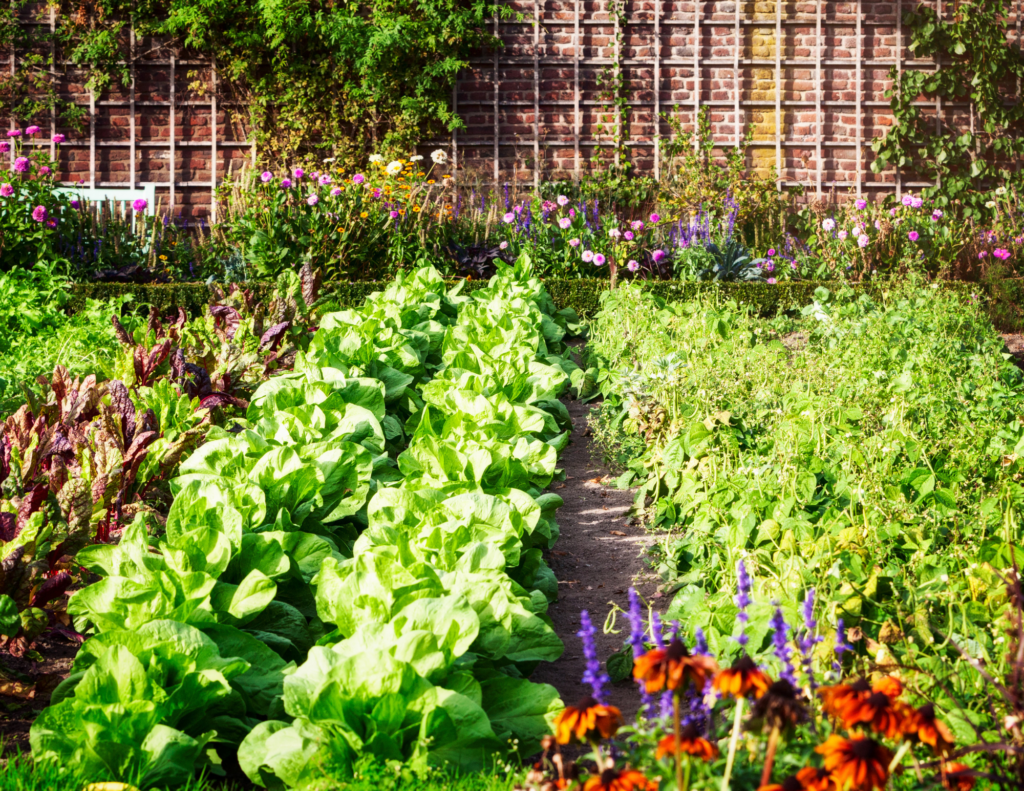Summer Clean-Up in Your Organic Garden and Preparing for Fall Crops

As summer winds down, it's the perfect time to start thinking about transitioning your organic garden from summer's bounty to fall's hearty crops. Summer clean-up and preparation for fall planting are crucial steps for maintaining a healthy and productive organic garden. This blog will guide you through the necessary steps for a thorough summer clean-up and introduce you to the top 10 fall fruits and vegetables to grow in your organic garden.
Step-by-Step Summer Clean-Up
- Harvest Remaining Summer Crops:
- Begin by harvesting any remaining summer crops. Tomatoes, peppers, cucumbers, and squash are typically still producing in late summer. Use these last fruits and vegetables in your meals or preserve them for later use through canning, freezing, or drying.
- Remove Spent Plants:
- Once you've harvested, remove any spent plants. Dead or dying plants can harbor pests and diseases, so it's essential to clear them out. Compost healthy plant material and discard any diseased or pest-infested plants to prevent the spread of problems in your organic garden.
- Weed Thoroughly:
- Weeds compete with your crops for nutrients and water. A thorough weeding session will help ensure that your fall crops have the best possible growing conditions. Pull weeds by hand or use a hoe to cut them off at the roots.
- Amend the Soil:
- After clearing out the old plants and weeds, it's time to amend the soil. Add compost, well-rotted manure, or organic fertilizers to replenish the nutrients that summer crops depleted. This will create a rich, fertile environment for your fall plants in your organic garden.
- Test the Soil:
- Conduct a soil test to determine the pH and nutrient levels. This information will help you make any necessary adjustments to ensure your soil is balanced and ready for fall planting.
- Cover Crops:
- Consider planting cover crops like clover or rye to improve soil structure, add organic matter, and fix nitrogen. These crops can be turned into the soil before planting your fall vegetables.
- Mulch:
- Apply a layer of organic mulch, such as straw or wood chips, to help retain moisture, suppress weeds, and moderate soil temperature. Mulching also adds organic matter to the soil as it decomposes, benefiting your organic garden.
- Irrigation Check:
- Inspect your irrigation system to ensure it’s working correctly. Fall crops need consistent moisture, so fix any leaks or clogs and adjust timers as needed.
- Plan Your Fall Garden:
- Take some time to plan which fall crops you want to grow and where you will plant them. Crop rotation is essential to avoid depleting the soil of specific nutrients and to reduce pest and disease problems in your organic garden.
- Start Seeds Indoors:
- Depending on your climate, you may need to start some fall crops indoors to give them a head start. Use seed trays or pots and provide plenty of light and warmth for germination.
Top 10 Fall Fruits and Vegetables to Grow
- Spinach:
- Spinach thrives in the cooler temperatures of fall. It's a fast-growing leafy green that's packed with vitamins and minerals. Sow seeds directly into the garden and enjoy fresh spinach in salads, smoothies, and cooked dishes from your organic garden.
- Carrots:
- Carrots are a versatile root vegetable that can be harvested throughout the fall and even into winter in some regions. Choose varieties suited for fall planting and ensure the soil is loose and free of rocks for straight, healthy roots.
- Broccoli:
- Broccoli is a cool-season crop that produces best in the fall. Start seeds indoors and transplant them into the garden when the weather cools. Broccoli is rich in vitamins C and K and makes a great addition to soups, stir-fries, and salads.
- Beets:
- Beets are hardy and can withstand light frosts, making them an excellent fall crop. Both the roots and greens are edible and nutritious. Sow seeds directly in the garden and thin seedlings to allow room for growth.
- Kale:
- Kale is a robust leafy green that becomes sweeter with cooler temperatures. It's packed with nutrients and can be used in salads, smoothies, and cooked dishes. Sow seeds directly in the garden or start transplants indoors.
- Brussels Sprouts:
- Brussels sprouts require a long growing season and are best planted in late summer for a fall harvest. These miniature cabbages are high in vitamins and minerals and can be roasted, steamed, or sautéed.
- Garlic:
- Plant garlic in the fall for a harvest the following summer. Choose hardneck or softneck varieties based on your climate. Garlic requires well-drained soil and plenty of sunlight to develop large, healthy bulbs.
- Turnips:
- Turnips are a quick-growing root vegetable that can be planted in late summer for a fall harvest. Both the roots and greens are edible and provide a good source of vitamins and minerals. Sow seeds directly in the garden and thin seedlings as needed.
- Radishes:
- Radishes are one of the fastest-growing fall crops, maturing in as little as three to four weeks. They add a peppery crunch to salads and can also be pickled or roasted. Sow seeds directly in the garden and thin seedlings to allow room for growth.
- Swiss Chard:
- Swiss chard is a hardy leafy green that can be harvested well into the fall. It comes in a variety of vibrant colors and can be used similarly to spinach and kale. Sow seeds directly in the garden or start transplants indoors.
ARTICLE CONTINUES BELOW
Schedule a Consultation TODAY!
We would love to sit down with you and chat about your experiences and current pain points.
The Benefits of Growing Your Own Organic Fruits and Vegetables
Growing your own organic fruits and vegetables offers a myriad of benefits, not just for your health, but also for your overall well-being and the environment. Here are some of the top advantages:
- Healthier Produce:
- Organic gardening ensures that your fruits and vegetables are free from harmful pesticides and synthetic fertilizers. This means you’re consuming produce that's not only fresher but also more nutritious and safe for you and your family.
- Better Taste:
- Homegrown produce often tastes better than store-bought varieties because you can pick them at their peak ripeness. There’s nothing quite like the flavor of a sun-warmed tomato or a crisp, freshly harvested carrot.
- Cost Savings:
- Growing your own produce can save you money. While there’s an initial investment in seeds, plants, and gardening supplies, the long-term savings on your grocery bill can be significant.
- Environmental Impact:
- Organic gardening practices help reduce your carbon footprint. By avoiding chemical pesticides and fertilizers, you protect the soil and local water sources from pollution. Plus, growing your own food reduces the need for transportation and packaging.
- Physical Activity:
- Gardening is a great form of exercise. It keeps you active and helps improve your strength, stamina, and flexibility. Activities like digging, planting, weeding, and harvesting all contribute to your physical fitness.
- Mental Well-being:
- Spending time in the garden can reduce stress, improve your mood, and enhance your overall mental well-being. Gardening provides a sense of accomplishment and can be a meditative activity that helps you connect with nature.
- Education:
- Gardening is a fantastic educational tool for children and adults alike. It teaches valuable lessons about biology, ecology, and the importance of sustainable practices.
- Food Security:
- Growing your own food increases your food security. You have control over what you grow and how it’s grown, ensuring a reliable supply of fresh produce.
- Biodiversity:
- By growing a variety of fruits and vegetables, you contribute to the biodiversity of your local ecosystem. This can attract beneficial insects and pollinators, helping to create a balanced and healthy garden environment.
- Community Connection:
- Gardening can foster a sense of community. Sharing your harvest with neighbors or participating in local gardening clubs can build connections and promote a sense of belonging.
The Joy of Harvesting Fresh Produce from Your Organic Garden
One of the most rewarding aspects of growing your own organic fruits and vegetables is the sheer joy of harvesting fresh produce right from your backyard. There’s something magical about stepping out into your garden, basket in hand, and picking ripe, juicy tomatoes, crisp lettuce, or fragrant herbs for your meals. This immediate access to fresh produce encourages healthier eating habits and inspires you to get creative in the kitchen with what you’ve grown.
Additionally, the experience of gardening fosters a deep appreciation for the natural world and the effort it takes to grow food. It can be incredibly fulfilling to see the fruits of your labor literally come to life, providing sustenance for you and your loved ones. The organic garden becomes more than just a space for growing food; it becomes a place of relaxation, reflection, and joy.
Conclusion
Preparing your organic garden for fall requires a bit of work, but the rewards are well worth it. By cleaning up your summer garden, amending the soil, and carefully selecting fall crops, you can enjoy a bountiful harvest of fresh fruits and vegetables. The top 10 fall crops we've highlighted—spinach, carrots, broccoli, beets, kale, Brussels sprouts, garlic, turnips, radishes, and Swiss chard—are all excellent choices for a productive and nutritious fall garden. With proper planning and care, your garden will thrive through the fall and provide you with delicious, homegrown produce to enjoy.
Schedule Your Telehealth Consultation
We would love to sit down with you and chat about your experiences and current health complaints.
The information on this website has not been evaluated by the Food & Drug Administration or any other medical body. We do not aim to diagnose, treat, cure or prevent any illness or disease. Information is shared for educational purposes only. You must consult your doctor before acting on any content on this website, especially if you are pregnant, nursing, taking medication, or have a medical condition.

By Dr. Todd W. Bunning
Dr. Todd W. Bunning’s Chiropractic and Functional Medicine services reach far beyond the local Roseville area, with webcam consultations available for patients in any location. With over 21+ years of Private Practice experience, Dr. Todd continues to focus on the individual: science-based methods to address whole-body health factors.
Dr. Todd’s education didn’t stop when he graduated from Life West Chiropractic College in 2003. Today, he’s continuing to receive training and is chipping away on numerous post-graduate degree programs. This unique blend of clinical health investigation and Lifestyle Medicine application helps people of all ages find the underlying factors that result in chronic disease.